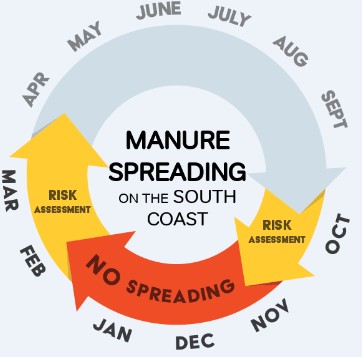Water table depth determination
The depth to the water table is a useful measure when planning manure applications. If water is near (within 60 cm/2 feet of) the surface, the risk associated with runoff or infiltration into the water table is great. If you have tile lines in your field, this is typically the depth they are at and can therefore transfer ill-applied manure to surface outlets. Always determine water table depth before manure applications, particularly during times of the year (October-May) when water tables are active and near the surface.
The water table depth can be determined by either using natural features or by digging a representative hole with a shovel or an auger. When digging a test hole, make sure that the area and elevation of the hole is representative of the entire field and is not over a tile line. Dig until water starts entering the hole, or to a maximum depth of 120 cm (4 feet). Allow the hole to settle and observe if water fills the hole within 1 hour. The level that water enters and fills the hole is the water table level. Make note of this depth. Multiple holes may be dug for greater accuracy. Fill the hole back in with the same soil immediately after use. If this is not done, the hole can become a direct conduit to groundwater pollution.
Instead of digging a hole, you may use a nearby ditch or other natural feature that is representative of the water table. Installation of a depth gauge can help with quick and accurate depth determination. Any natural feature should be verified with a second method prior to consistent use as a measure of water table depth.
Courtesy Whatcom Conservation District

The BC Application Risk Management tool can be used to complete a risk assessment.
Contact information
AgriService BC
Have a question? Call or email and ask for a soil or nutrient management specialist to assist you.
Telephone: 1 888 221-7141
E-mail: AgriServiceBC@gov.bc.ca
